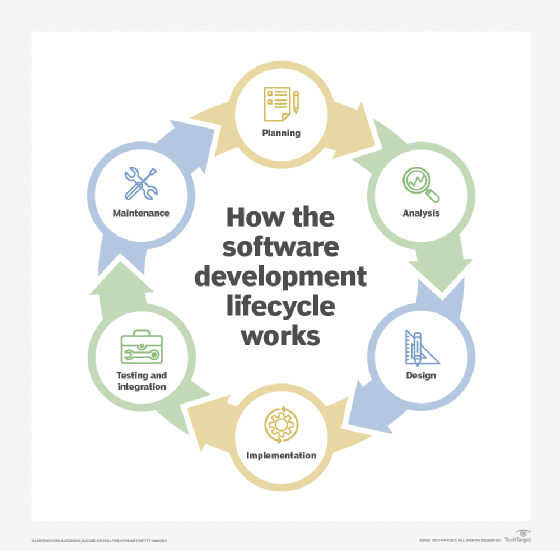What is static application security testing (SAST)?
Static application security testing (SAST) is the process of analyzing and testing application source code for security vulnerabilities. Software developers use SAST to find and fix flaws in source code early in the software development lifecycle (SDLC) before the final release of the app.
How does SAST work?
SAST is a white box testing method, meaning it analyzes an application from the inside -- examining source code, bytecode and binaries for design flaws -- while the app is inactive. A SAST scan can occur early in the SDLC because it does not require a working application or code to be deployed.
Since SAST occurs early in the SDLC, it can provide developers with real-time feedback, which enables them to resolve issues with the code before it is passed on to the next step of the SDLC. It is important to note that SAST tools must be used on a regular basis to ensure vulnerabilities are caught anytime the app undergoes a new build.

Besides being used with mobile and web applications, SAST tools can be applied to code in embedded systems.
The majority of SAST tools are compatible with leading industry compliance regulations, such as the following:
- Payment Card Industry Data Security Standard.
- Health Insurance Portability and Accountability Act.
- Motor Industry Software Reliability Association.
It is important that SAST tools support both the programming language -- like Java or Python -- and the application framework.
Key steps to run SAST effectively
To perform SAST effectively, organizations should perform the following steps:
- Choose the proper SAST tool. The tool should be compatible with the programming language so that it can perform code reviews of applications written in the respective language. The tool should also integrate with the underlying framework the company’s software uses.
- Create the scanning infrastructure and deploy the tool. This involves handling the licensing requirements, setting up access control and authorization, and obtaining the necessary resources, such as servers and databases to deploy the tool.
- Customize the tool to suit the needs of the business. For instance, a company might configure the tool to find additional security vulnerabilities by writing new rules or updating current ones. The new configurations could reduce the possibility of false positives by writing new rules. A false positive is when a test result wrongly lists a security vulnerability, displaying the flaw as present when it is not. SAST tools are also integrated into the app's build environment with the creation of dashboards and custom reports.
- When the tool is ready, assign applications to test. Organizations with many apps should prioritize the high-risk ones and scan them first. After onboarding all the applications, organizations should scan them on a regular basis and sync the scans with release cycles.
- Once the test is complete, analyze scan results to remove false positives. After the issues are finalized, they should be tracked and handed off to the deployment teams for remediation.
Throughout this process, it is important to properly train and oversee the development team to guarantee they are using the SAST tools appropriately.
Benefits of SAST
SAST can help evaluate both server-side and client-side security vulnerabilities. This approach helps developers find vulnerabilities in the early stages of the development process, enabling them to immediately fix any issues and prevent additional costs or problems caused by dealing with issues at the end. The real-time feedback provided by this approach lets teams remove flaws before moving further along in the SDLC, helping prevent security issues from becoming an afterthought.
SAST tools can be automated and integrated into a project's development environment, enabling developers to monitor their code regularly. SAST tools can provide graphical representations of discovered flaws, making the code easy to navigate. Some tools even point out the exact location of vulnerabilities and highlight the faulty code.
SAST tools can scan millions of lines of code in minutes and automatically identify key vulnerabilities, including Structured Query Language injection, cross-site scripting and buffer overflows, improving the overall quality of the code. By tracking all the security vulnerabilities found by the test, developers can fix the flaws quickly and release the application with the smallest number of issues.
Another benefit of SAST is its ability to help verify a developer's compliance with coding guidelines and standards. Scrum masters and product owners can use SAST tools to help regulate security standards within their development teams and organizations, enabling increased code integrity and faster reduction of vulnerabilities.
Challenges of SAST
SAST tools can be incompatible with other tools in some instances. They need to be selected to integrate with an organization's programming environment, languages and frameworks.
Furthermore, SAST tools cannot identify vulnerabilities outside of the source code, leaving room for external flaws, such as weaknesses in third-party interfaces. These vulnerabilities might present themselves only once the application is running. SAST tools do not examine applications during runtime.
Another challenge created by SAST is false positives. These errors can be time-consuming since they force developers to trace and analyze the code to separate the false positive results from the accurate ones.
Importance of SAST
The biggest advantage that organizations have over hackers is the ability to access an application's source code. SAST uses this advantage to delete vulnerabilities in the early stages of development before they are exposed. Introducing SAST into the SDLC can improve the quality of code since the tools automatically discover critical weaknesses.
Furthermore, it's difficult for organizations to complete manual code reviews on every application consistently. SAST tools enable all the applications and codebase to be analyzed, providing full coverage. SAST assists organizations in automating the security process, enabling quick and accurate solutions to flaws and vulnerabilities, as well as consistent improvements of the code's integrity.
SAST vs. DAST
For comprehensive security testing, SAST is often used with dynamic application security testing (DAST). While SAST is a white box testing method and analyzes an app from the inside, pinpointing exactly where vulnerabilities are found, DAST is a black box testing method. DAST evaluates the app from the outside, launching fault injection techniques to discover threats.
SAST discovers vulnerabilities early on in the SDLC, and DAST uncovers flaws and weaknesses at the end. As a result, it is less expensive to fix vulnerabilities found through SAST than DAST.
One advantage that DAST has over SAST is the former's ability to discover runtime- and environment-related issues. DAST tools are also less likely to report false positives. Furthermore, DAST can understand arguments and function calls, enabling it to determine if a task is acting as it should. SAST is unable to check calls and usually cannot check argument values either.
Finally, SAST can be automated and integrated into the SDLC. DAST requires a special infrastructure for large projects. For DAST to be successful, teams must perform special tests and provide several samples of the app running in parallel with other input data.





